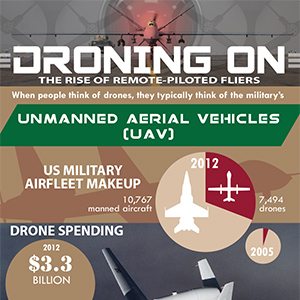The drones graphic discusses the use of micro-drones in spying and general surveillance, to supplement the much bigger drones that most people are familiar with.
Droning On The Rise of Remote Piloted Flying
In Kathleen Ann Goonan’s 1994 science fiction/ nanopunk novel “Queen City Jazz”, she introduced enormous bio-engineered bees that “fertilized” giant nanotech flowers on tops of highrise buildings with data. While we’re not at the “bio-nan” stage where organisms are enhanced with nanotech, there are studies in progress in which bees and possibly other large insects have RFiD chips attached.
These chips have wireless technology that allows collected environmental data to be transmitted to a hub. Of course, these are real bees. Then there are the non-organic “microdrone” robotic flying craft, not much larger than the living counterparts that inspired these drones — including one known as the RoboBee. While scientists and engineers are trying to get microdrones to work together like a swarm of bees, the military is considering their use in spying and general surveillance, to supplement the much bigger drones that most people are familiar with.
How Can Drones Be Used?
Drones of all types have already been used in a wide range of practical ways, including Archaeological surveying, military, and meteorology, Wildlife conservation, tracking orangutans in Sumatra and monitoring several endangered species. Namibia has teamed up with the WWF (World Wildlife Fund) to fly drones over national parks, in hopes of spotting poachers, as well as monitoring animals.
Types of Drones
There are several types of drones that can be used collectively for the purposes above. Here are a few, which come in all shapes and sizes. Quadcopters, as well those with 6 or even 8 blades. Larger unmanned aerial vehicles (UAV) resemble small helicopters and planes, and sometimes even larger planes. Microdrones, are insect-sized and sometimes insect-shaped and have flapping wings. There are also somewhat larger bird-inspired drones with flapping wings.
Bird and Insect Drones
In the 1990s, one of his former students, Charles Ellington, also a zoologist, created a robotic wing that mimicked hawk moth movements. Neurobiologist Michael Dickinson built a robotic wing inspired by the fruit fly. In 1998, the electrical engineer Ron Fearing won a $2.5M DARPA grant to create a fly-sized model unsuccessfully accomplished after 7 years by Rob Wood, who had started the project while still a grad student.
TechJet created a robotic dragonfly with a 6-in wingspan, weight 5.5 grams (less than an American quarter). The DelFly Explorer is the world’s smallest non-tethered drone with flapping wings, at 20 gm in weight, with a 28cm wingspan. (The RoboBee is tethered.) The British military is already using non-insect-shaped microdrones for scouting missions in Afghanistan. Other insects – and bird-inspired drones include the Nano Hummingbird, Dragonfly, and RoboBee. The RoboBees creator, Rob Wood, speculates that they could be used in swarms at disaster sites to search for survivors.
Drone Swarms
Robotic insect swarms are actually difficult to produce because of limitations on battery life, especially at microdrone sizes. However, Hungarian researchers have managed to assemble a team of 10 drones that self-organize themselves as they fly. These quadcopters have GPS, wireless radios, and processors which collectively allow the pack to navigate in a formation, follow a leader, and more. The team behavior was modeled after pigeons. Other researchers have videos on YouTube showing packs of multiple mini quadcopters working in a team to do something athletic or musical.
Killer Drones
While most uses of drones are non-destructive, some are used for unmanned military strikes against enemies. Usually referred to as UAVs (Unmanned Aerial Vehicles), they come in a variety of shapes and sizes, some of which carry missiles. While drones are remotely controlled, some can take off and land on their own, even from aircraft carriers. U.S. DOD (Dept of Defense) spending on drones increased from $284M in 2000 to $3.3B in the fiscal year previous (to Oct 2012).
The graph of CIA drone strikes in Pakistan by year, for 2004-2013, shows a “bell curve” for both a number of strikes and casualties — which suggests that maybe the U.S. and UK war effort there may be declining, but at least that casualties are declining. The similarity of shapes strongly suggests that civilian casualties in 2010 climbed to a peak of 874 (total number killed) because that was also a peak year for strikes in Pakistan.
Definition of Combatant
It should be noted that the U.S. military definition of “combatant” is a bit loose, making it possible to claim that no civilians were killed in a particular drone strike. According to the Bureau of Investigative Journalism, if an intended target is killed in a strike and nearby males of military age are also killed, they are deemed “combatants” even if, according to investigative journalists and UN investigators, they were simply innocent male civilians.
Also, critics of the killer drones including one writer in The Guardian who claims to have worked on the U.S. drone program point out that video feedback is so poor that you cannot tell the difference between a shovel and a gun. A remote pilot under pressure may end up striking unintended targets. Fortunately, future military drones will be smaller and have more accurate weapons, presumably resulting in lower numbers of civilian casualties. It’s very likely that we’ll see ever more drones in the near future, including in the USA, for law enforcement and general surveillance. While some uses are destructive, most are valuable to many fields and industries.
Related:
- What Is The Department of Homeland Security?
- 20 Best Security MPA Degrees
- How Do I Get Certified in Homeland Security?
- 10 Top Online Homeland Graduate Certificate Programs
- Top 10 Online Homeland Security Certificate Programs

